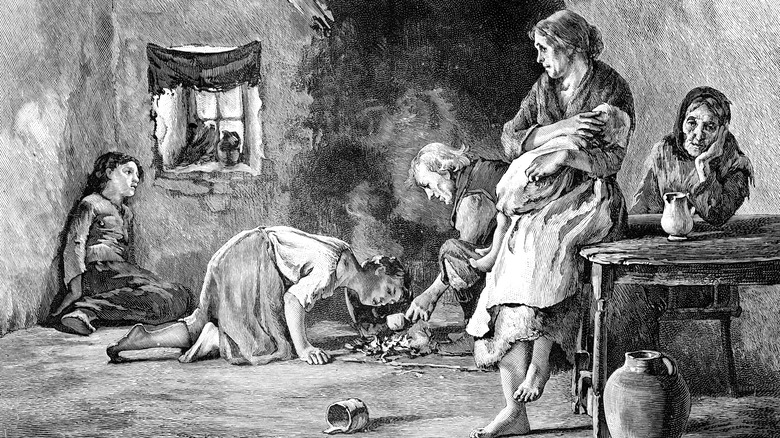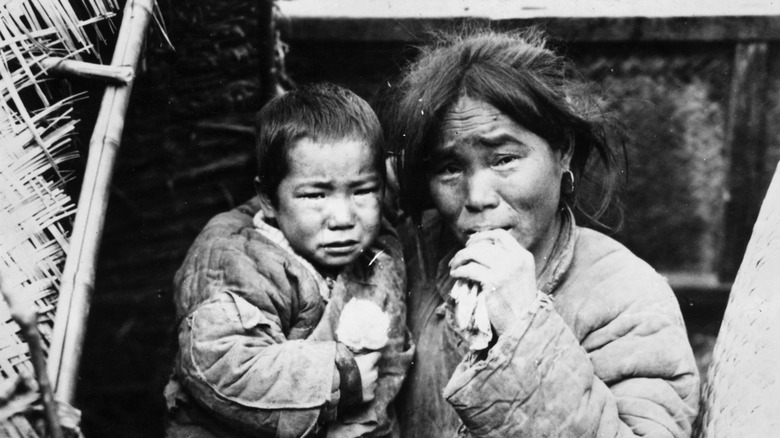The Deadliest Famine In History That's Too Taboo To Talk About
Famines have been a part of history for centuries and have been caused by many things, including war, crop failure, and even bad economic policies. Famines were especially deadly during early Medieval times, when a single harvest fail could mean death for entire towns. According to Europe Now, there were several very poor harvest seasons between 1210 and 1350 that are likely to have resulted in a food crisis.
Although famine has affected every continent, the 19th and 20th centuries saw the most famines occur in Asia and Europe. During the 21st century, Africa has become the continent most affected by famine. In modern times, famine has been driven more frequently by conflict and climate change, as well as rising crop prices, as explained by the World Food Programme.
Government corruption and currency depreciation are also reasons behind famines in modern times. According to the World Food Programme, 41 million people are at risk of famine around the world in 2021, with large populations in four countries — South Sudan, Ethiopia, Yemen, and Madagascar — currently living in famine-like conditions.
Data from the World Health Report 2000 (WHO) shows that up to 9 million people a year die of causes related to hunger and poverty, including lack of access to clean water and malnutrition. This is about 25,000 people per day (per the Food and Agriculture Organization).
Some of the biggest famines built up over decades
The biggest famine of the 19th century was the Irish Potato Famine, which took place in 1845–49 in Ireland due to massive crop failure caused by a mold disease. While the loss of a single crop is usually not enough to cause famine, Ireland was in a particularly difficult position, as the poor depended on potatoes as the main staple of their diets in the 1840s (via Britannica). Despite some efforts from the government to import corn to feed those starving, the population of Ireland went from 8.4 million in 1844 down to 6.6 million in 1851 because of the famine.
On the other hand, the ongoing famine in Africa is driven in part by political instability, human rights abuse, and the long-term effects of AIDS, according to Human Rights Watch. The 1998 Sudan famine, one of the biggest ever to affect Africa, was caused by a civil war that affected the region for over 20 years. By 1998, famine had become a humanitarian disaster in South Sudan, killing an estimated 250,000 people. According to World Vision, over 7 million people in East Africa are at risk of starvation today, and over 250 million people in the entire continent are dealing with being chronically undernourished due to poor harvests and political and social conflict.
The largest famine ever happened in modern times
Known as China's "Great Leap Forward" famine, the 1959-61 famine was the largest ever in the world in terms of deaths. The Great Leap Forward was a two-year campaign organized by the Chinese Communist Party to reconstruct the country by organizing people into communes to undertake huge projects and solve agricultural and industrial problems (via Britannica). However, the system was poorly implemented, and as a result, the focus shifted to steel production, leaving much of the 1958 harvest to rot in the fields.
As part of the Great Leap Forward campaign, the Chinese government had also started a war against four pests: mosquitoes, rats, flies, and (unexpectedly) sparrows. With sparrows gone, locust swarms descended on the crops and destroyed anything that could have been saved to feed the population (per History of Yesterday).
Although it's hard to know how many people truly died during the famine, research published in the British Medical Journal (BMJ) estimates the numbers at between 16.5 million and 23 million, although unpublished research conducted in China puts the total at around 40 million. In addition, there were long-lasting consequences in the population, such as a massive fall in birth rates (via Our World in Data).


